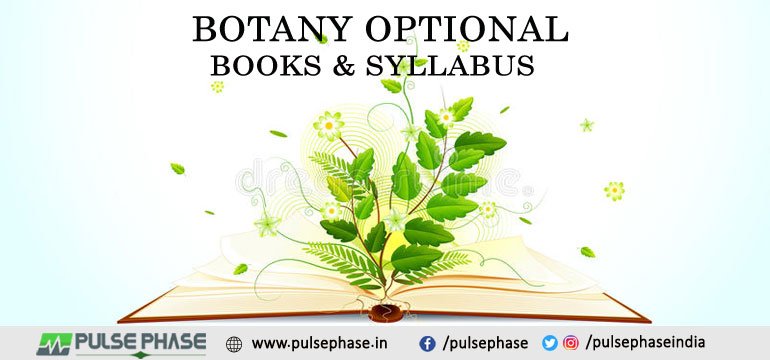UPSC is one of the most privileged exams of the nation that allows the aspirants to choose the optional subject of their choice. Botany Books and Syllabus UPSC Mains has two optional subjects out of nine subjective papers. Candidates can select these two subjects from 48 subjects.
There are two papers of botany exam and marks of each paper are 250. So, the total marks of both papers will be 500. Before landing on the preparation strategy for preparation, you must be well-versed with the optional syllabus of botany for UPSC exam.
If you have been searching for a detailed optional syllabus for botany, then this is the apt guide designed to suit your requirements to the optimum level.
Best Books for Botany optional for UPSC Exam
Botany upsc books are all that you need for the Botany optional Books For IAS exam. Botany optional is selected by a lot of students since it’s a concept based subject. Botany is an optional subject that is selected mainly by students from science backgrounds. In upsc exams, botany optional is considered as a scoring subject since questions asked are straightforward and based on concepts. Most of the students prefer to refer botany optional books for upsc before appearing exams.
List of Best Botany Optional Books for UPSC
- Physiology and Biochemistry -Salisbury and Ross or Fritz and Noggle
- Plant Anatomy- Esau
- Plant Anatomy- B.P. Pandey
- Taxonomy-R Nair
- Systematic Botany-S C Datta
- Botany for Degree Students; Pteridophyta (Vascular Cryptogams)-P.C. Vashishta
- Ecology, Microbiology, Animal Behaviour, Pollution and Toxicology For B. Sc. Part III, Paper III- Dr Veer Bala Rastogi
- Economic botany in the tropics- S. L. Kochhar
- Cell Biology- De Robertis & Ambrose and Easy or Powar
- Cryptograms- B.R. Vasista
- Elements of Genetics-Dr. Veer Bala Rastogi
- Microbiology- Powars
- Pathology- Singh’s book along with a foreign author
- Embryology Of Angiosperms- S P Bhatnagar
- Genetics- Strickberger
Botany Optional Syllabus Paper for UPSC Exam-I
- Plant Pathology and microbiology: viruses’ multiplication and structure, viroids, mycoplasma, bacteria and fungi; microbiology applications in the industry of agriculture, control of pollution and medicine in water, soil and air, Phyto Immunology, important diseases of plants due to mycoplasma, nematodes, bacteria, fungi and viruses. Dissemination and infection’s mode; measures of control and parasitism physiology.
Molecular basis of defence of disease and infection. Modelling and forecasting of disease; fungal toxins.
- Cryptogams: lichens, Pteridophytes, algae, bryophytes, fungi- multiplication based on evolution. In India, cryptograms’ distribution and their economic significance.
- Phanerogams: Angiosperms: phylogeny, embryology, systematics, palynology and anatomy. Hierarchy of taxonomy; numerical taxonomy; relative account of different angiosperms categories’ systems. Study of families of angiosperms- Brassicaceae, Asclepiadaceae, Magnoliaceae, Rosaceae, Solana-ceae, Ranunculaceae, Leguminosae, Dipterocar-paceae, Verbenaceae, Euphorbiaceae, Apiaceae, Poaceae, Liliaceae, Malvaceaie, Malvaceaie, Rubiaceae, Orchidaceae and Cucurbitaceae. Stomata and types of stomata. Abnormal secondary development, Anatomy of plants known as C3 and C4. Pollination, Gametophyte’s development (male and female), fertilization. Endosperm- development of endosperm and function of endosperm. Patterns of embryo development of embryos. Applications of palynology, polyembryony and apomixis.
- Development of plant resource: Plants’ introduction and domestication; cultivated plants’ base, centres of origin of Vavilov. Starch, latex and cellulose and products related to them. Ethnobotany’s importance in the context of India. Perfumery. Plants as origin for fibres, narcotics, food, resins, drugs, fodder, gums, spices, insecticides, dyes, beverages and timber. Plantation of energy. Gardens of botany and Herbaria.
- Morphogenesis: Polarity,Diversity and symmetry, totipotency. Culture of protoplast, cell, organ and tissue. Somatic cybrids and hybrids; Application of Somaclonal variation; Rescue methods of embryo and their application; Micropropagation; Pollen haploids.
Botany Optional Syllabus Paper for UPSC Exam -II
Botany is a concept based subject that is selected mainly by students from science backgrounds. It’s syllabus may appear to students from non science backgrounds. This optional subject requires students to remember a lot of fundamental and technical names. Many people find these technical names really difficult to memorize. It’s better to choose this subject as an optional only if you are capable of memorizing technical names. Below paragraphs deals with the syllabus of botany optional for upsc in detail
- Biology of cell: Cell biology’s techniques; cells (Prokaryotic and eukaryotic)- details included (structural and ultrastructural); structure of cell wall and its function, membranes- transport of membrane, vesicular transport and cell adhesion; cell organelles’ function and structure; microtubules and cytoskeleton; nucleolus, nuclear pore complex, nucleus; Cell receptors and signalling; Mitosis and meiosis; Nucleosome and chromatin; Signal transduction; Origin of cell cycle based on molecules; Various alterations in chromosomes and their importance; Polytene chromosomes; Structure, importance and behaviour of B-chromosomes; Organization of chromatin and genome’s packaging.
2. Biostatistics, Breeding of plant and Biotechnology: Different techniques of plant breeding—overview, assortment and crossbreeding. Heterosis breeding. In plant breeding, utilization of apomixis. Male sterility. Micropropagation and engineering related to genes-techniques of genes transfer and transgenic crops; In plant breeding, development and utilization of molecular markers. Coefficient of variation. Standard deviation. Importance tests. Correlation and regression. Different distributions and probability.
3. Molecular biology, Genetics and Development: Genetics development; Concepts of allele Vs. genes; Quantitative genetics and numerous features; Techniques of gene mapping; Crossing over and connection; Inheritance related to sex and sex chromosomes; Mutations; molecular basis of differentiation of sex; Cytoplasmic genes and inheritance. Genetic code. Protein and nucleic acids’ structure and synthesis; Gene silencing; Gene expression’s regulation; Multigene families; In basis and development, part of RNA.
4. Geography of plant and Ecology: Factors of ecology. Ideas of the biosphere. Plant succession. Pollution and control of pollution. Ideas and acts of community. Ecosystems and conservation of ecosystems.
5. Biochemistry and Physiology: mineral nutrition and deficiencies, water relations, ion transport. Photosynthesis—photophosphorylation; Fixation pathways of C; C3, C4 and CAM pathways; Phloem transport’s mechanism; Respiration phosphorylation; Oxidative phosphorylation; Lipid metabolism; Secondary metabolites’ significance; Metabolism and fixation of nitrogen; ATP synthesis; Enzymes; Chemiosmotic theory; Coenzymes; Conservation and transfer of energy; Photoreceptors in the form of pigments; Movements of plant; vernalization, flowering, senescence; Substances, movements and indices of growth; Fruit, stress and seed physiology; Seed germination, dormancy and storage; Fruit ripening.
Bottom Line
Botany optional syllabus has been discussed in detail in this article. If you are someone who has opted for this option, then go through the syllabus well so that you are well acquainted with every aspect of the syllabus. Never jump into preparation directly by not visiting the syllabus properly. Your preparation needs to have a firm grip on your syllabus. So, prepare well and have a distinguished plan for your study.
Read More:-




